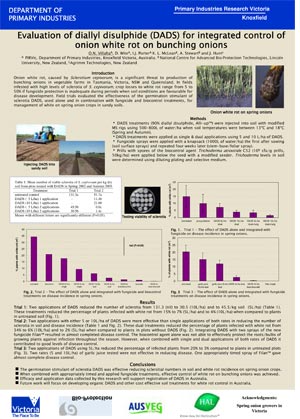|
|
This poster summarises the findings of field trials aimed at evaluating DADS (80% diallyl disulphide, Alli-Up�) as part of an integrated strategy for the sustainable control of onion white rot. Thi work better informs vegetable growers of control options for this soil-borne disease and choose the most appropriate and effective use of chemical and biological treatments for disease management on their farms. Onion white rot, caused by Sclerotium cepivorum, is a significant threat to production of bunching onions in vegetable farms in Tasmania, Victoria, NSW and Queensland. In fields infested with high levels of sclerotia of S. cepivorum, crop losses to white rot range from 5 to 50% if fungicide protection is inadequate during periods when soil conditions are favourable for disease development. Field trials evaluated the effectiveness of the germination stimulant of sclerotia DADS, used alone and in combination with fungicide and biocontrol treatments, for management of white on spring onion crops in sandy soils.
Synthetic diallyl disulphide or DADS (80% diallyl disulphide, Alli-Up�) was very effective reducing the population of sclerotia of S. cepivorum in soil and disease incidence on spring onion crops. This soil treatment applied before planting can be a cost-effective soil treatment for white rot control on commercial spring and other bunching onion crops. DADS needs to be integrated with other control measures that protect the roots of growing plants from infection to obtain more effective disease control throughout the growing season. For instance, when DADS was combined with correctly applied and timed fungicide treatments (eg Filan�) or early season applications of the biocontrol agent T. atroviride (Trichople Ali 52�), effective and sustainable control of white rot was obtained. Commercialisation of DADS in Australia is being prevented by a reliable supplier of DADS, cost of treatments and costly registration process. When registered, DADS has the potential to provide an immediate increase in return per hectare but the benefits of the treatment will persist for several cropping seasons. Other chemical treatments readily available (eg dazomet, metham sodium) can reduce the population of sclerotia in soil but these can be too expensive and would require optimisation before their widespread use for white rot control in Australia. Conclusions :
Acknowlegements : There were many people and organisations that provided assistance to make this research possible. They include:
The authors thank the members of the Steering Committe, Rocky Lamattina, Tony Lamattina, Craig Arnott, Karl Riedel and others for their valuable advice to this project. This project was commissioned by Horticulture Australia Limited with funds frrom the Vegetable R&D levy.. The Australian Government provides matched funding for all HAL’s R&D activities. |
||||||||
|

